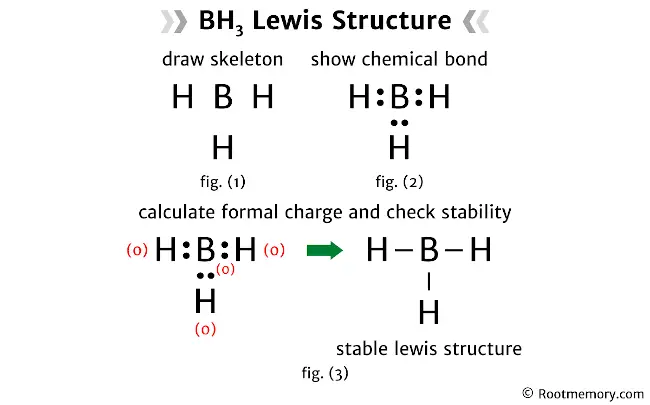
The Lewis structure of BH3 contains three single bonds, with boron in the center, and three hydrogens on either side. There are no lone pairs on both the boron atom and hydrogen atom.
Alternative method: BH3 Lewis structure
Steps
Draw skeleton
In this step, first calculate the total number of valence electrons. And then, decide the central atom.
- Let’s calculate the total number of valence electrons
We know that… boron is a group 13 element and hydrogen is a group 1 element. Hence, boron has three valence electrons and hydrogen has one valence electron.
Now BH3 has one boron atom and three hydrogen atoms.
So the total number of valence electrons = valence electrons of boron atom + (valence electrons of hydrogen atom × 3)
Therefore, the total number of valence electrons = 3 + 3 = 6
- Now decide the central atom
We can not assume hydrogen as the central atom, because the central atom is bonded with at least two other atoms. And hydrogen has only one electron in its last shell, so it can not make more than one bond.
Hence, assume that boron is the central atom.
So now, put boron in the center and hydrogens on either side. And draw the rough skeleton structure for the Lewis structure of BH3 something like this:

Also read: How to draw Lewis structure of NCl3 (4 steps)
Show chemical bond
Place two electrons between the atoms to show a chemical bond. Since boron is surrounded by three hydrogens, use six electrons to show three chemical bonds as follows:

In the above structure, you can see that the octet is completed on outside atoms. But, the central atom (boron) doesn’t form an octet.
Now boron has an exception in BH3, that it does not require eight electrons to complete its octet.
So one last thing we need to do is, calculate the formal charge and check the stability of the above structure.
Also read: How to draw Lewis structure of BrF5 (4 steps)
Calculate formal charge and check stability
The following formula is used to calculate the formal charges on atoms:
Formal charge = valence electrons – nonbonding electrons – ½ bonding electrons
Collect the data from the above structure and then, write it down below as follows:
- For boron atom
Valence electrons = 3
Nonbonding electrons = 0
Bonding electrons = 6
Formal charge = 3 – 0 – ½ (6) = 0
- For each hydrogen atom
Valence electrons = 1
Nonbonding electrons = 0
Bonding electrons = 2
Formal charge = 1 – 0 – ½ (2) = 0
Mention the formal charges of atoms on the structure. So the Lewis structure of BH3 looks something like this:

In the above structure, you can see that the formal charges of both (boron and hydrogen) are zero. Therefore, this is the stable Lewis structure of BH3.
And each horizontal line drawn in the above structure represents a pair of bonding valence electrons.
Next: Lewis structure of NCl3
Related
- Lewis structure of NCl3
- Lewis structure of BrF5
- Lewis structure of BrF3
- Lewis structure of HF
- Lewis structure of IF5
External video
- BH3 Lewis Structure – How to Draw the Lewis Structure for BH3 – YouTube • Wayne Breslyn
External links
- Chemical Bonding: BH3 Lewis Structure – The Geoexchange
- BH3 Lewis Structure in 5 Steps (With Images) – Pediabay
- BH3 molecular geometry, lewis structure, bond angle, hybridization – Topblogtenz
- Lewis Structure of Borane (BH3) – Chemistry School
- In the Lewis structure of BH3, it only has 3-bond electrons around the B atom. Isn’t this wrong according to the octet rule? – Quora
- What is the Lewis dot structure of BH3? – Socratic
- Lewis structure of borane BH3 – Chemistry Online
- Draw the 3D Lewis Structure of borane, BH3 – Chegg
- Lewis Dot of Borane BH3 – Kent’s Chemistry
- Draw the lewis structure of BH3 – Brainly
- File:BH3 Lewis.png – Wikimedia Commons
Deep
Rootmemory.com was founded by Deep Rana, who is a mechanical engineer by profession and a blogger by passion. He has a good conceptual knowledge on different educational topics and he provides the same on this website. He loves to learn something new everyday and believes that the best utilization of free time is developing a new skill.
